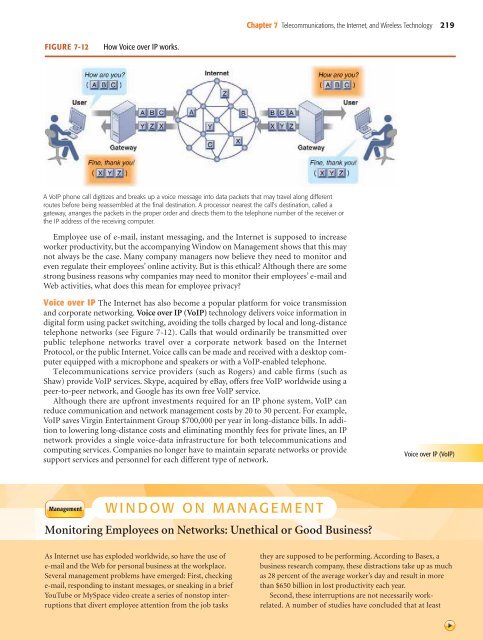Telecommunications, the Internet, and Wireless ... - Pearson Canada
Telecommunications, the Internet, and Wireless ... - Pearson Canada
Telecommunications, the Internet, and Wireless ... - Pearson Canada
Create successful ePaper yourself
Turn your PDF publications into a flip-book with our unique Google optimized e-Paper software.
Chapter 7 <strong>Telecommunications</strong>, <strong>the</strong> <strong>Internet</strong>, <strong>and</strong> <strong>Wireless</strong> Technology 219<br />
FIGURE 7-12<br />
How Voice over IP works.<br />
A VoIP phone call digitizes <strong>and</strong> breaks up a voice message into data packets that may travel along different<br />
routes before being reassembled at <strong>the</strong> final destination. A processor nearest <strong>the</strong> call’s destination, called a<br />
gateway, arranges <strong>the</strong> packets in <strong>the</strong> proper order <strong>and</strong> directs <strong>the</strong>m to <strong>the</strong> telephone number of <strong>the</strong> receiver or<br />
<strong>the</strong> IP address of <strong>the</strong> receiving computer.<br />
Employee use of e-mail, instant messaging, <strong>and</strong> <strong>the</strong> <strong>Internet</strong> is supposed to increase<br />
worker productivity, but <strong>the</strong> accompanying Window on Management shows that this may<br />
not always be <strong>the</strong> case. Many company managers now believe <strong>the</strong>y need to monitor <strong>and</strong><br />
even regulate <strong>the</strong>ir employees’ online activity. But is this ethical? Although <strong>the</strong>re are some<br />
strong business reasons why companies may need to monitor <strong>the</strong>ir employees’ e-mail <strong>and</strong><br />
Web activities, what does this mean for employee privacy?<br />
Voice over IP The <strong>Internet</strong> has also become a popular platform for voice transmission<br />
<strong>and</strong> corporate networking. Voice over IP (VoIP) technology delivers voice information in<br />
digital form using packet switching, avoiding <strong>the</strong> tolls charged by local <strong>and</strong> long-distance<br />
telephone networks (see Figure 7-12). Calls that would ordinarily be transmitted over<br />
public telephone networks travel over a corporate network based on <strong>the</strong> <strong>Internet</strong><br />
Protocol, or <strong>the</strong> public <strong>Internet</strong>. Voice calls can be made <strong>and</strong> received with a desktop computer<br />
equipped with a microphone <strong>and</strong> speakers or with a VoIP-enabled telephone.<br />
<strong>Telecommunications</strong> service providers (such as Rogers) <strong>and</strong> cable firms (such as<br />
Shaw) provide VoIP services. Skype, acquired by eBay, offers free VoIP worldwide using a<br />
peer-to-peer network, <strong>and</strong> Google has its own free VoIP service.<br />
Although <strong>the</strong>re are upfront investments required for an IP phone system, VoIP can<br />
reduce communication <strong>and</strong> network management costs by 20 to 30 percent. For example,<br />
VoIP saves Virgin Entertainment Group $700,000 per year in long-distance bills. In addition<br />
to lowering long-distance costs <strong>and</strong> eliminating monthly fees for private lines, an IP<br />
network provides a single voice-data infrastructure for both telecommunications <strong>and</strong><br />
computing services. Companies no longer have to maintain separate networks or provide<br />
support services <strong>and</strong> personnel for each different type of network.<br />
Voice over IP (VoIP)<br />
WINDOW ON MANAGEMENT<br />
Monitoring Employees on Networks: Unethical or Good Business?<br />
As <strong>Internet</strong> use has exploded worldwide, so have <strong>the</strong> use of<br />
e-mail <strong>and</strong> <strong>the</strong> Web for personal business at <strong>the</strong> workplace.<br />
Several management problems have emerged: First, checking<br />
e-mail, responding to instant messages, or sneaking in a brief<br />
YouTube or MySpace video create a series of nonstop interruptions<br />
that divert employee attention from <strong>the</strong> job tasks<br />
<strong>the</strong>y are supposed to be performing. According to Basex, a<br />
business research company, <strong>the</strong>se distractions take up as much<br />
as 28 percent of <strong>the</strong> average worker’s day <strong>and</strong> result in more<br />
than $650 billion in lost productivity each year.<br />
Second, <strong>the</strong>se interruptions are not necessarily workrelated.<br />
A number of studies have concluded that at least
















